The Russian Bear Dog is a working breed, developed to guard livestock against wolves. They are confident, alert, loyal and protective, yet laid back and affectionate to their owners. Named after the Caucus Mountains they are known as Caucasian Shepherds, Caucasian Ovcharkas or Caucasian Mountain Dogs. This large 200lb, 30 inch powerful breed suits experienced dog owners in big homes. They are expensive to buy, feed and insure. Their heavy brown, grey, black and cream fur coat is long and high shedding. These pups need a lot of grooming and live on average a healthy 12 years. Russian Bear Dog bites are also said to be stronger than lions, and they aren’t always comfortable with kids or other pets. Today we’ll look at how the Russian Bear Dog’s breed traits suit family life. We’ll look at behavior, personality, health, and the training, exercise and care needs of this massive canine.
Although they look like Shihloh Shepherds and King Shepherds, the Caucasian Shepherd is totally unrelated. Russian Bear Dog breeders are usually very picky about where their puppies go. That’s because Russian Bear Dogs are very special dogs and they have special needs. If you are thinking of adopting an adult or bringing a new puppy it’s very important that you learn about the socialization and management of this fascinating breed, and understand their limitations as a family pet. With his massive size and stunning good looks, this is certainly a big bear of a dog with a personality to match. But is this the right dog for you? Let’s find out!
Caucasian Ovcharka Litter (Pinconning, Michigan, USA)
Posted: June 23, 2022 Updated: September 7, 2022 Price: ask
We have puppies!
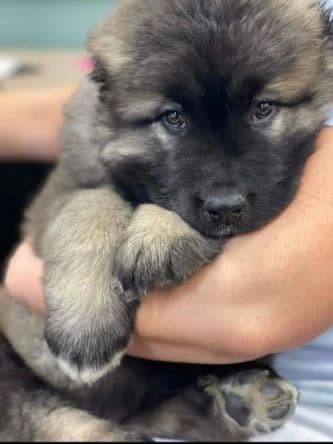
Our pups are full-blood caucasian Ovcharkas. They come up to date on shots, deworming, registered microchips, vet-checked, health certificates, puppy bags, and papers. They are AKC (FSS) and UKC registered. Socialized and raised with children to make for the perfect balance of protective yet family/children friendly.
I do temperament testing as well so I can provide you with the right puppy/temperament that fits your home/family, as well as trying to teach name recall (if you choose your name before they leave) and start working on potty training and training basics.
If you do decide to inquire/receive a puppy from us there will be a written contract, a non-refundable ($100) deposit to hold a puppy, and I do expect to be able to stay in contact with you if you purchase through me.
I do not breed for the money, I breed for hobby and enjoyment so the puppies that leave me are my pride and joys and I want to be able to stay in contact throughout their lifetime. They will forever be a part of our family and important to us. When purchasing through Heart of the Ocharka you will be guaranteed lifetime support for the dog/you. Said Dog is always welcome back per written contract if it does not work out.
Please dont inquire if this is not something you are willing to uphold on your end because they are very important to me. I go through labor with mom, help her birth by her side and devote every waking minute to the development and health of my dam and her puppies.
Those who choose are welcome to come into our home at any time to choose/see their puppy and weekly pictures will be sent out for updates, more often if requested. Requirements to purchase your lifelong pet through us are to have a fenced yard (verified) and knowledge of the Breed. Please do your research on this breed of dog if you are unsure about them to ensure this will be the right fit for your home. They are not suited for apartment living so please do not inquire if this is the case.
More about us and Puppy applications are available/ required to be filled out on our website: heartoftheovcharka.com
Facebook page/group Heart of the Ovcharka The Majestic Caucasian ovcharka
Phone:989-397-4580
Please text/messenger me first, I am very responsive to those I do not answer unknown calls. If you are unable to message then you may call and leave a voice mail and I will get back to you as soon as I can.
Russian Bear Dog Characteristics & Overview
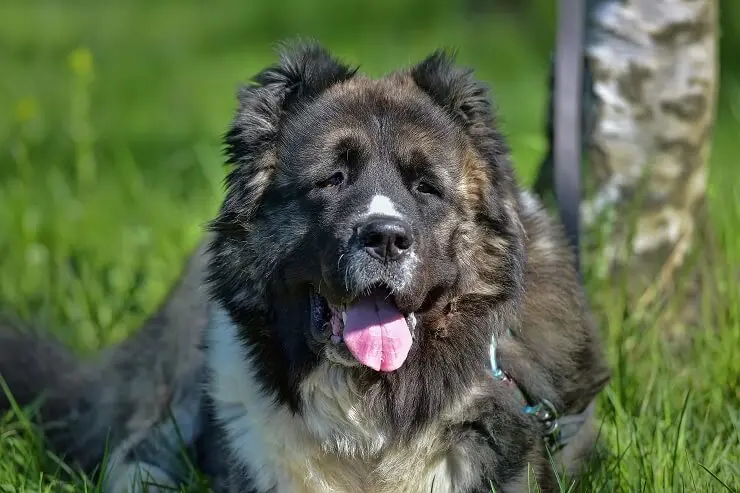
| Common names: | Russian bear dog, Caucasian shepherd dog, Caucasian mountain dog, Caucasian ovcharka dog |
| Origin: | Southern Russia, Caucasus |
| Breed group: | Working dog |
| Size: | Large |
| Height: | 23–30 inches |
| Weight: | 99–170 pounds |
| Colors: | Brown, gray, black, cream, white, brindle, fawn, apricot |
| Coat: | Double coat, medium-to-long length |
| Life expectancy: | Intelligent, but can be difficult to train |
| Temperament: | Loyal, alert, aloof, energetic, confident, protective |
| Shedding: | Heavy shedders |
| Barking tendency: | Moderate |
| Cost: | $1,200–$3,000 |
The Russian bear dog originated in the Caucasus mountain region in the twentieth century. The dog was originally used as a livestock guardian dog to defend sheep from predators like bears, wolves, and jackals.
Today, these dogs work as prison guard dogs in Russia and are also popular companion dogs.
The average lifespan of the Russian bear dog is 10–12 years.
Factors affecting the dog’s lifespan are its health status, activity level, diet, and genetics.
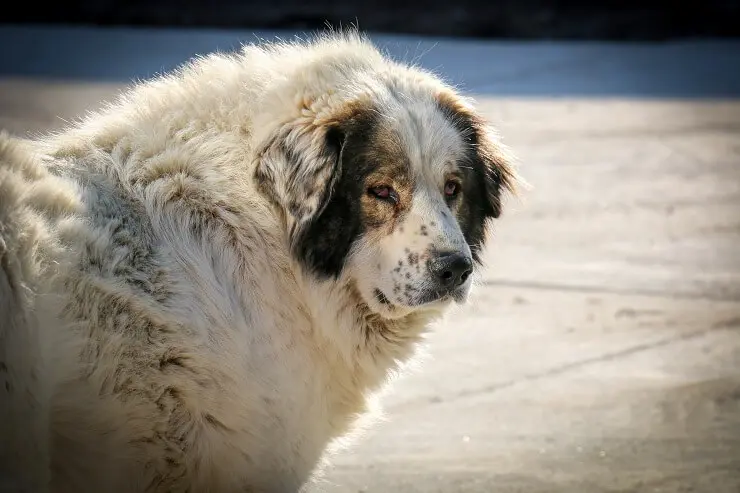
The Russian bear dog was bred to be big and strong enough to fight predators, like wolves. This breed is one of the largest dog breeds.
The dog’s thick, fluffy fur comes in solid, piebald, and spotted color variations.
Russian bear dogs are considered large dogs, with a height at the withers of 23–30 inches, and a weight of 99–170 pounds. The height and weight of the dog depend on its diet, activity level, and the size of its parents.
Males are bigger and have larger heads than females.
Commonly, Russian bear dogs are a combination of two or three colors, typically white, black, or brindle. Other colors include brown, gray, cream, fawn, and apricot.
Many dogs of this breed have black muzzles and white chests. Solid-color black or white dogs are rare.
The Russian bear dog was bred to have a thick, coarse double coat to withstand freezing temperatures. The dog’s undercoat is soft and fluffy, and the outer coat is wiry and medium-to-long in length.
These dogs are heavy shedders and shed their old coats in the spring in preparation for warm weather. They are not hypoallergenic.
Russian bear dogs have a broad, bear-like face with a short, powerful muzzle that tapers off to a black nose. The dog has dark, deep-set, oval eyes, and pointy teeth that resemble fangs.
Originally, the Russian bear dog’s ears were cropped to prevent predators from biting them. Now, although ear cropping is still supported by the American Kennel Club, many veterinarians consider cropping dogs’ ears unnecessary mutilation.
Russian Bear Dog Temperament and Personality
The Russian bear dog is a confident, loyal, high-energy dog that’s fiercely protective of its family and wary of strangers. The breed is independent, intelligent, and alert.
The dog is known to be challenging to train. A first-time dog owner or person inexperienced with canine behaviors shouldn’t own a Russian bear dog.
Although Russian bear dogs have protective guarding instincts, the dogs’ barking tendencies are low. The dogs bark when they sense a threat, such as strangers entering their home, but the breed isn’t known to bark excessively due to boredom or anxiety.
Socialization from a young age should prevent excessive barking at strangers.
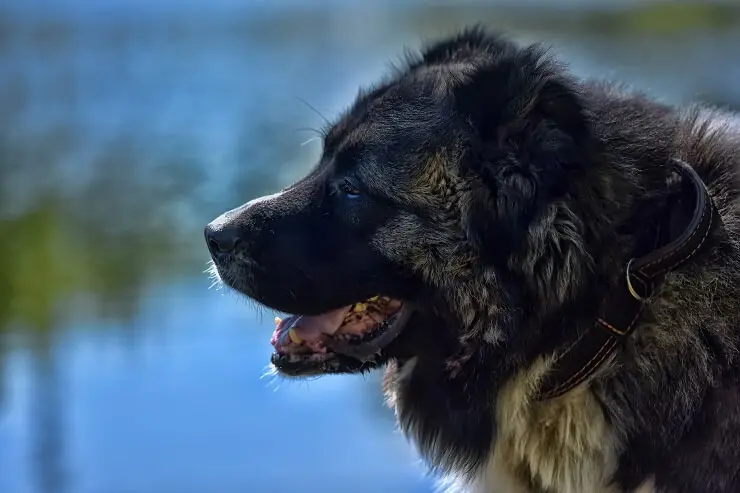
Russian bear dogs are large dogs with high exercise and food requirements. Taking care of the dogs is challenging and expensive.
The Russian bear dog needs 8 to 10 cups of good-quality kibble per day. To reduce the risk of bloat, puppies’ food should be divided into four meals per day. Adults should eat two or three separate meals per day.
The dog’s size and activity level affect its food requirements, so speak to your veterinarian if you’re unsure exactly how much food your dog needs.
The Russian bear dog’s long, thick coat should be brushed at least twice a week, or up to once per day during shedding season. Use a slicker brush to detangle knots in the undercoat, gently brushing in the direction that the fur grows.
Wash the dog every four to six weeks, or when the coat looks dirty and begins to smell unpleasant.
Russian bear dogs need at least one hour of exercise per day, divided into a minimum of two separate walks. This dog is unsuitable for apartment living because it needs constant access to a backyard to stretch its legs between exercise sessions
To prevent skeletal development abnormalities in this breed, exercise the dog while it’s still a puppy. The duration of exercise for a puppy is five minutes for every month of age.
For example, a five-month-old puppy should be exercised for a maximum of 25 minutes.
The Russian bear dog needs at least 30 minutes of mental stimulation per day to maintain its great intelligence. Games like fetch, frisbee, and find-and-retrieve are stimulating for this breed.
Puzzle toys are a good way to keep the dog entertained while you’re busy, but finding a suitably-sized toy for this large dog can be difficult.
Common health issues the Russian bear dog faces include:
As a large dog breed, the Russian bear dog is prone to elbow and hip dysplasia. These conditions cause the hip and elbow joints to form incorrectly, resulting in lameness, limping, pain, stiffness, and a “wobbly” walk.
Avoid hip and elbow dysplasia by buying a puppy from a breeder who has cleared the parent dogs of these conditions. Hip and elbow dysplasia is treated with exercise therapy, a controlled diet, weight loss (if necessary), and surgery.
Bloat, or gastric dilation and volvulus (GDV), is the accumulation of gas or fluid in the stomach, and primarily affects large dog breeds like the Russian bear dog.
Signs of bloat include a swollen, hard belly, retching but not vomiting, drooling, excessive panting, and restlessness.
Reduce the risk of bloat by feeding the dog multiple small meals instead of one large meal, avoiding elevated food bowls, and restricting exercise immediately before and after meals. Bloat is life-threatening and causes death if not treated immediately with surgery.
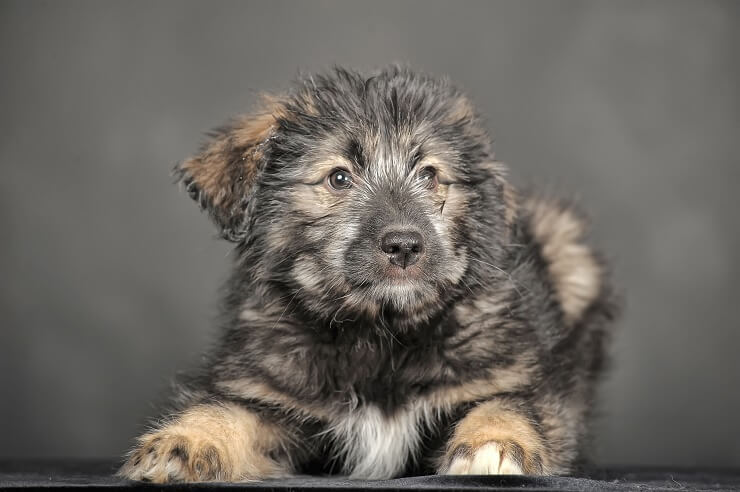
Russian bear dogs are easy to train but can be stubborn, so they need to be trained from a young age with reward-based training and positive reinforcement.
The dogs have a wary nature, so they should never be trained with punishments.
Begin training and socializing this dog at eight weeks old, starting with leash and toilet training. Then, teach the dog important commands, like “sit” and “heel.”
Introduce the dog to a variety of people, other dogs, and situations in a safe, controlled manner.
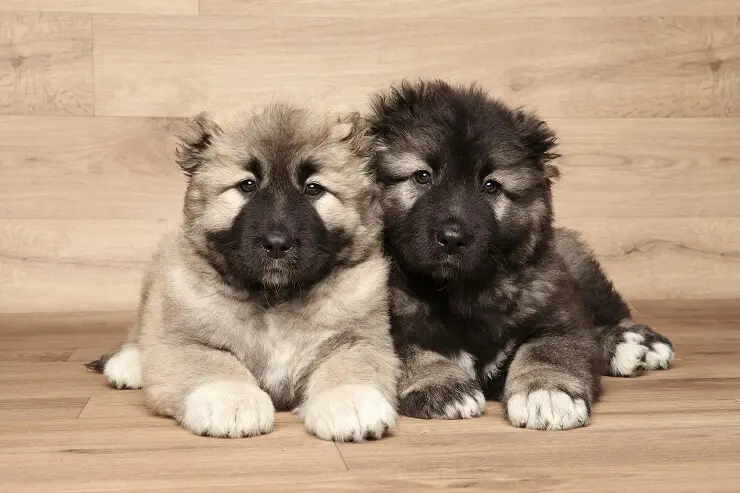
Russian bear dogs are expensive. Adopting an adult dog is much cheaper than buying a puppy, but the dogs are rarely available for adoption.
FAQ
How much does a Russian guard dog cost?
How big do Russian bear dogs get?